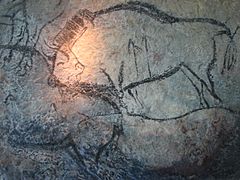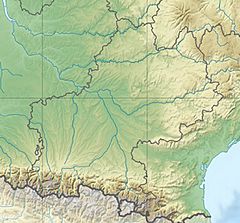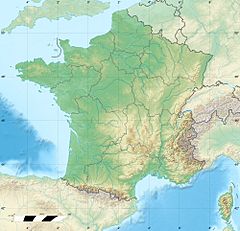Cave of Niaux facts for kids
|
Grotte de Niaux
|
|

copy of a bison painting in the Salon Noir
|
|
| Location | Niaux |
|---|---|
| Region | Ariège, southwestern France |
| Coordinates | 42°49′15″N 01°35′37″E / 42.82083°N 1.59361°E |
| Type | limestone |
| Part of | caves in the Tarascon river basin |
| History | |
| Periods | late Upper Paleolithic, 17,000 to 11,000 years ago |
| Cultures | Magdalenian |
| Associated with | Paleo Humans |
| Site notes | |
| Archaeologists | Emile Cartailhac |
The Cave of Niaux (French: Grotte de Niaux) is a famous cave located in the Niaux area of southwestern France. It is part of a larger cave system that includes other well-known caves like Sabart Cave and Lombrives Cave.
The Niaux Cave system is very big. It has more than 14 kilometers (about 8.7 miles) of underground tunnels and rooms. This cave is an important archaeological site. Ancient humans lived here a very long time ago. Inside, you can find many amazing wall paintings. These paintings are very clear and were made with black outlines. They are typical of the Magdalenian period, which was between 17,000 and 11,000 years ago.
Contents
What is the Cave of Niaux?
The Cave of Niaux is a prehistoric cave known for its ancient art. It is located in a beautiful valley in the Vicdessos area of France. This cave is one of the few places where you can still see incredible prehistoric paintings up close.
Who discovered the cave?
A scientist named Félix Garrigou, who studied prehistoric times and water, visited the cave in 1869. He was the first person to suspect that the cave was very old and important. He wrote about it in his diary.
How was the cave explored?
In 1869, Commander Molard and his sons found a special part of the cave called the Salon Noir (Black Hall). After they shared a map of the cave, experts became very interested. Just one year later, famous archaeologists Henri Breuil and Emile Cartailhac explored it. This exploration helped the cave become widely recognized.
In 1925, J. Mandeman found another area with black paintings. He named it the Cartailhac Gallery. Later, in 1971, Jean Clottes and Robert Simonnet led a big scientific study of the cave. Then, in 1980 and 1981, a team of scientists made a complete list of all the pictures inside the cave.
What can you see inside the cave?
The Niaux Cave is special because it has been kept in its natural state. The floor is often wet, bumpy, and can be slippery. So, if you visit, you need to wear strong walking shoes!
In 1970, another part of the cave system was found. It was called the Reseau Clastres. This area has ancient footprints and a rare drawing of a weasel made with charcoal.
The Black Hall: A Gallery of Ancient Art
The Salon Noir (Black Hall) is one of the most famous parts of the cave. The artists used mostly black paint, with some red for certain symbols.
- Bison paintings: The most common animal painted here is the bison. You can see a female bison with a small hump on the left side. On the right, there's a male bison with a much bigger hump.
- Horse paintings: The lower part of the wall shows several horses. These horses have a lot of hair, like the Przewalski horse, which is a very old type of horse.
- Goat paintings: There are also two goats. One looks very real, while the other is drawn in a simpler, more basic way.
These amazing paintings in the Black Hall are believed to be about 13,000 years old!
Visiting the Cave
Because the original cave is so delicate, a copy of Niaux's Salon Noir has been made. This copy shows the paintings exactly as they were. You can see this copy, along with other figures from the cave, at the Park of Prehistoric Art. This park is located near Tarascon-sur-Ariège.
See also



